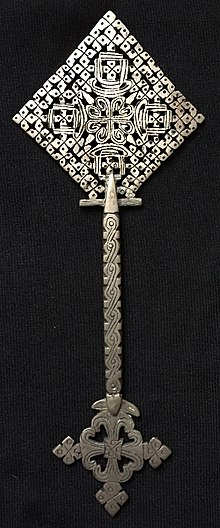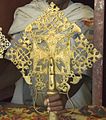

Ethiopian crosses, Abyssinian crosses, or Ethiopian-Eritrean crosses are a grouping of Christian cross variants that are symbols of Christianity in Ethiopia, Eritrea, and among Ethiopians and Eritreans. Their elaborate, stylized design is markedly distinct from other Christian cross variants .[1][2] Ethiopian crosses are almost always made from elaborate latticework, the intertwined lattice represents everlasting life.[3] No two crosses are exactly identical in style, the artisans who make them being allowed the freedom to exercise a measure of individual taste and creativity in their choice of shape and pattern. Crosses may be of the processional type with a socket at the base so they may be mounted on a staff and carried in church ceremonies or hand-held blessing crosses used by priests in benedictions.[4]











